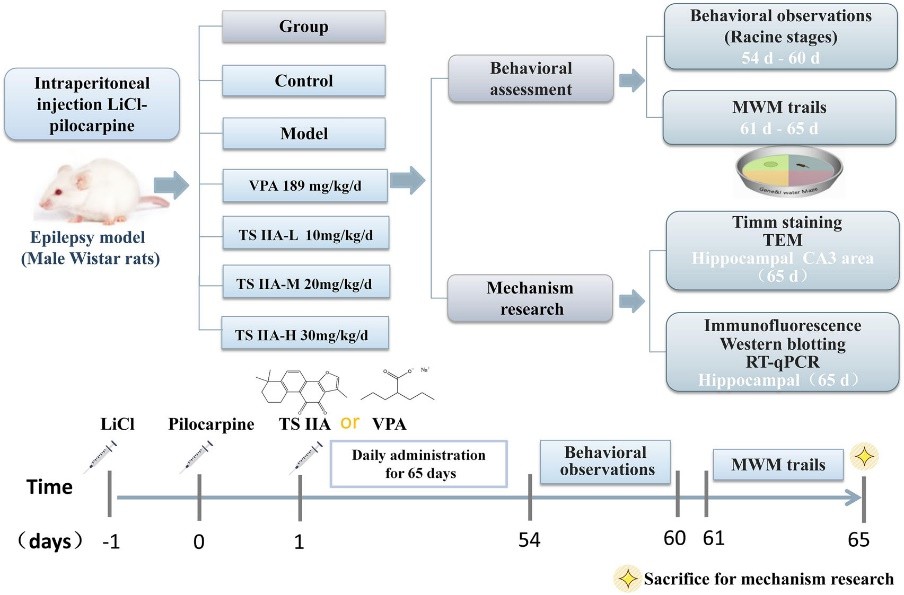Nervous System Disease Model Construction Service for Exosome Functional Research
Overview Disease Model FAQs
Overview
Exosome research is an emerging and rapidly developing field that has received increasing attention. In existing studies, exosomes have played a significant role in targeting, immunogenicity, and carrying biologically active molecules, making them play an important role in the treatment of nervous system diseases (NSDs). These suggest that researchers can start from the direction of exosomes to find new therapeutic avenues. During the development of therapeutic exosomes, the selection of appropriate animal models is helpful for the development of effective therapeutic drugs. Creative Biolabs can provide a variety of stable and high-quality NSD animal models to help customers achieve their goals.
 Fig.1 Research diagram of the mechanism of tanshinone IIA to improve cognitive function via synaptic plasticity in epileptic rats. (Jia, 2023)
Fig.1 Research diagram of the mechanism of tanshinone IIA to improve cognitive function via synaptic plasticity in epileptic rats. (Jia, 2023)
Creative Biolabs Nervous System Disease Model Library for Exosome Functional Research
We can provide including but not limited to the following NSD animal models for exosome functional research.
Creative Biolabs is a professional exosome research technology supplier, which can provide one-stop services including exosome extraction, exosome identification, exosome engineering, exosome labeling, and in vivo and in vitro verification of exosomes. With the support of a strong high-level team and the support of senior biotechnology experts, we can provide high-quality NSD animal models and supporting experimental services for global customers. Please contact us to put forward your needs to customize a rigorous experimental plan for you.
Reference
-
Jia, C.; Zhang, R.; et al. Investigation of the mechanism of tanshinone IIA to improve cognitive function via synaptic plasticity in epileptic rats. Pharmaceutical Biology. 2023. 61(1):100-110.
FAQs
What role do exosomes play in nervous system diseases, and how can they be harnessed for disease modeling?
Exosomes are implicated in the pathogenesis of various nervous system diseases, including neurodegenerative disorders, stroke, and brain tumors. Our service utilizes exosomes to construct disease models that replicate key pathological features, providing valuable platforms for studying disease mechanisms and testing therapeutic interventions.
How are exosomes sourced for nervous system disease model construction, and what advantages do they offer in this context?
Exosomes can be isolated from cerebrospinal fluid, blood, or neuronal cells, serving as reservoirs of disease-specific biomarkers and mediators. Utilizing exosomes for disease modeling offers advantages such as physiological relevance, non-invasiveness of sample collection, and the ability to capture disease-specific molecular signatures for accurate modeling.
Which nervous system diseases can be modeled using exosomes, and how faithfully do these models mimic human pathophysiology?
Our service enables the modeling of various nervous system diseases, including Alzheimer's disease, Parkinson's disease, stroke, and glioblastoma. These models closely mimic human pathophysiology by incorporating disease-associated exosomes containing biomolecules indicative of disease status, facilitating the study of disease progression and therapeutic responses.
What methodologies are employed in constructing nervous system disease models using exosomes, and what experimental approaches are involved?
Nervous system disease models are constructed by administering disease-associated exosomes to relevant in vitro or in vivo model systems, such as neuronal cultures or animal models. Experimental approaches include exosome uptake assays, functional assays, histological analysis, and molecular profiling techniques to assess disease-relevant phenotypic changes and therapeutic responses accurately.
Can these exosome-based disease models be customized to address specific research questions or therapeutic targets?
Yes, our service offers customizable disease models tailored to address specific research questions, therapeutic targets, or experimental requirements. Researchers can choose disease-relevant exosome sources, model systems, disease endpoints, and outcome measures, allowing for flexible study designs and the exploration of diverse research avenues.
For Research Use Only. Cannot be used by patients.
Related Services:

 Fig.1 Research diagram of the mechanism of tanshinone IIA to improve cognitive function via synaptic plasticity in epileptic rats. (Jia, 2023)
Fig.1 Research diagram of the mechanism of tanshinone IIA to improve cognitive function via synaptic plasticity in epileptic rats. (Jia, 2023)








